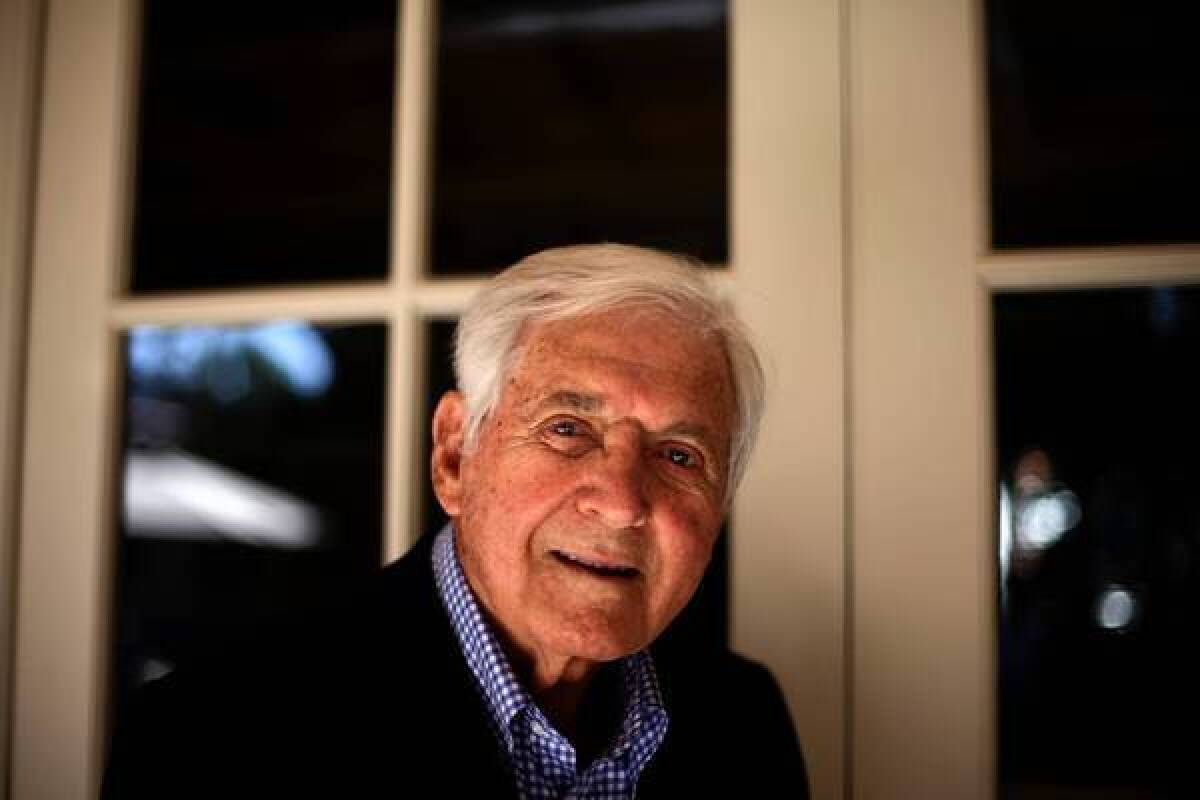After 4,000 ‘Let’s Make a Deal’ episodes, an Emmy for Monty Hall

After doing more than 4,000 episodes over the last half-century of his iconic daytime game show “Let’s Make a Deal,” Monty Hall is finally getting an Emmy Award.
“TV’s Big Dealer” is receiving the Lifetime Achievement Award at the 40th Daytime Entertainment Emmy Awards airing Sunday on Turner Broadcasting’s HLN.
His wife of 65 years, Marilyn Hall, beat him to the podium nearly 30 years ago, winning an Emmy as a producer of the 1985 CBS TV movie “Do You Remember Love?”
PHOTOS: Behind-the-scenes Classic Hollywood
“I’m going to place the Emmy on a shelf next to my wife’s Emmy and maybe one day we’ll have little Emmys,” Monty Hall said with a smile during a recent interview at his comfortable Beverly Hills home.
Hall is a few months shy of his 92nd birthday — not that he shows it. He announced with great pride that he still does the New York Times crossword puzzle — “in ink” — every day. And he still has his hand in the current incarnation of “Let’s Make a Deal,” which airs weekdays on CBS with Wayne Brady as host.
He’s an owner of the series and a consultant, plus he’s made several appearances with Brady on the series, including the recent 50th anniversary show. In fact, Hall says he’s hosted “Let’s Make a Deal” every decade since it began on NBC in late 1963.
He loves what Brady is doing with the series.
“He’s making it his show,” said Hall. “He’s learning the star of the show is the contestant and to make them feel at home, make them feel like they came to your party.”
The concept for “Let’s Make a Deal,” which was created and produced by Hall and Stefan Hatos, was inspired by “The Lady, or the Tiger,” Frank R. Stockton’s short story about a person who has to make a choice between two curtain-draped tents — behind one is a tiger, the other a lady.
PHOTOS: Hollywood Backlot moments
Hall and Hatos got rid of the tiger, expanded the choices to three curtains and introduced the word “zonk” into the lexicon of popular culture. Over the last 50 years, thousands of contestant have gotten zonked after choosing the wrong curtain or box. Instead of winning money, furniture, cars or a trip, they ended up with such gag gifts as barnyard animals and broken-down cars.
The original series’ announcer, Jay Stewart, lived for zonks, Hall said. “I said at his funeral, ‘He would come in the morning and look at the script and if there wasn’t a zonk for him to dress up like an old grandmother with a spinning wheel or a baby in a cradle, he would sulk.’”
Hall got his first taste of performing while at the University of Manitoba in his native Winnipeg, Canada, during World War II.
“I got a job at a radio station while I was going to college,” he said. “I worked from 6 p.m to midnight. I did everything. I had a singing show, a cowboy show. On Saturdays, I would get up and emcee at army shows.”
Eventually, he made his way to Toronto, where he worked in radio and TV. The summer of 1955, he tried his luck in New York. After a few lean months, Hall got a meeting with an executive at NBC and was offered to take over the daytime series “The Sky’s the Limit.”
Sometimes, he had only a night to prepare for a hosting gig, such as in 1960 when he took over the reigns from Jack Narz on the CBS game show “Video Village.” A personal issue caused Narz to suddenly quit the New York-based series and go to Los Angeles.
PHOTOS: Celebrity portraits by The Times
“I got a call,” Hall said. “They yanked me off the golf course somewhere and said whatever you are doing come to this hotel and learn the game. You are going on the air live tomorrow morning. That night they taught me the game.”
Hall recalled that in the early planning for “Let’s Make a Deal,” he and his staff would try out a simple version of the game for clubs and organizations to see what would work.
“We would call and say when you have a meeting, we’ll be your entertainment. We did it for lawyers’ groups and we did it for the Latter-day Saints quilting bee at 8 in the morning. Everywhere we showed it, they loved it.”
But there was no plan for contestants to dress up in wacky outfits to get Hall’s attention.
“They came to the show in the first week in suits and dresses,” he said. “The second week, a woman, noting I am picking people at random, came with a sign that says ‘Roses are red, violets are blue. I came here to deal with you.’ I read the sign and I picked her. The next week everybody had a sign. Then the next week, came the Phyllis Diller look-alikes and it grew and grew.”
Are you an aficionado of iconic Hollywood? Like us on Facebook and go to the Classic Hollywood landing page to get more Times coverage.
More to Read
The complete guide to home viewing
Get Screen Gab for everything about the TV shows and streaming movies everyone’s talking about.
You may occasionally receive promotional content from the Los Angeles Times.







